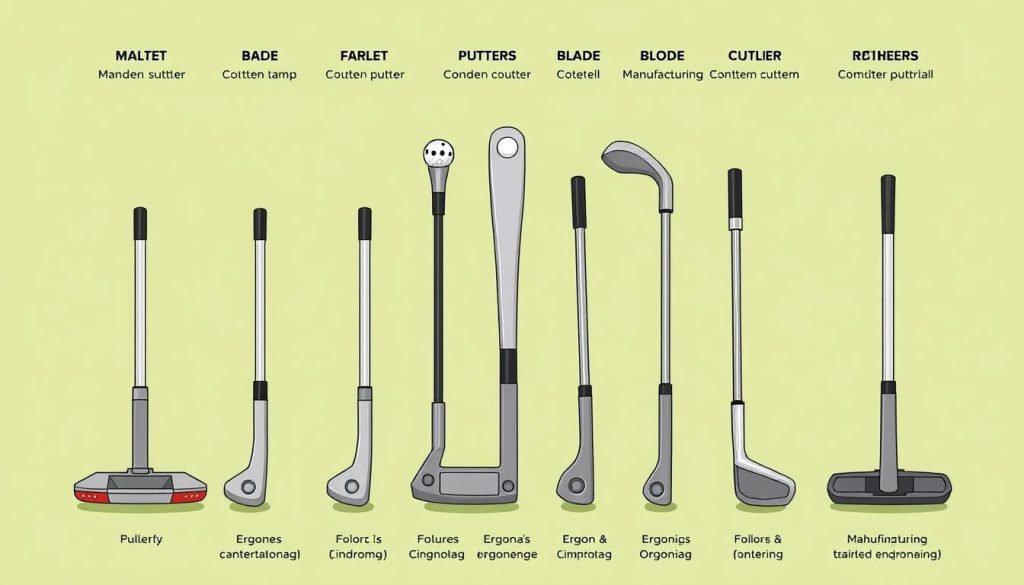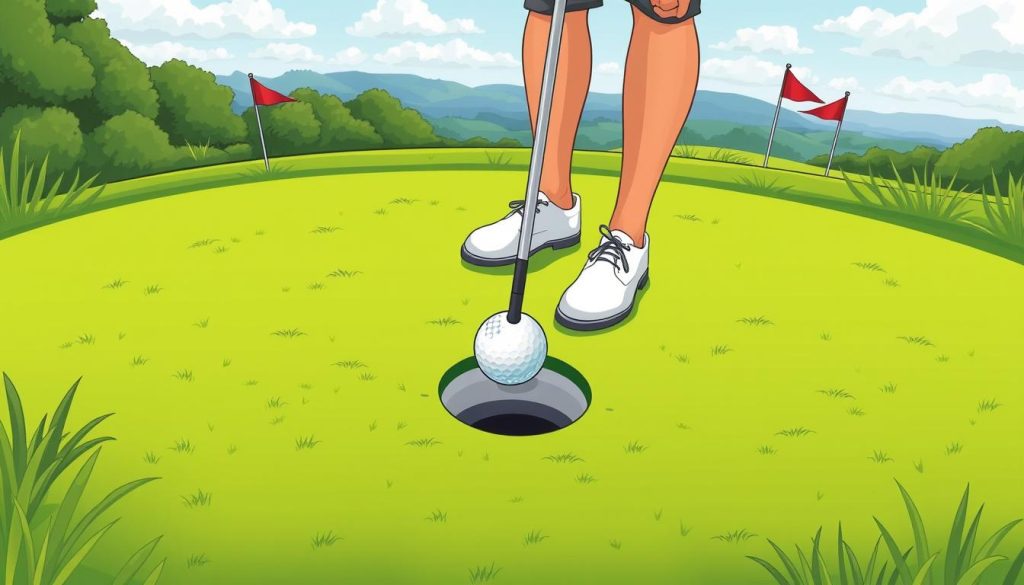Mastering the putting stroke is key to lowering your golf scores. This guide covers the basics of a good putting technique. It focuses on golf posture and stroke mechanics. You’ll also learn about ergonomic grip methods and stance optimization to boost your green accuracy.
We’ll dive into the importance of weight distribution and advanced putter designs. You’ll see how pros like Viktor Hovland have perfected their techniques for great results.
Whether you’re new to golf or looking to improve, this guide is for you. It will help you develop a consistent and comfortable putting stroke. By using these ergonomic tips, you’ll sink more putts and enhance your game.
Key Takeaways
- Proper putting technique combines stance, alignment, and grip
- Golf posture significantly impacts putting accuracy
- Ergonomic grip methods can enhance control and consistency
- Stroke mechanics vary based on putter design and personal style
- Customizing putter length and fit is essential for optimal performance
- Physical conditioning plays a role in maintaining good putting form
Understanding the Fundamentals of Putting Stroke Mechanics
Mastering the art of putting starts with understanding stroke mechanics. This section covers key elements for a consistent and effective putting stroke.
Basic Principles of a Proper Putting Stance
A solid putting stance is the base of your stroke. Stand with your feet shoulder-width apart and knees slightly bent. This stance helps keep you stable and balanced.
Your eyes should be directly over the ball. This creates a straight line from your eyes to the ball. It’s important for a good putt.
The Role of Body Alignment
Correct body alignment is key for consistent putting. Your shoulders, hips, and feet should line up with your target. This ensures your putter face is square at impact, improving accuracy.
Use alignment aids on the practice green to get better at your setup.
Weight Distribution Techniques
Proper weight distribution is crucial for your stroke. Keep your weight evenly on both feet, with a bit more on your front foot. This balance helps you move smoothly and maintain balance.
| Aspect | Technique | Benefit |
|---|---|---|
| Stance | Shoulder-width apart | Stability and balance |
| Eye Position | Directly over ball | Improved accuracy |
| Body Alignment | Parallel to target line | Consistent stroke path |
| Weight Distribution | Slightly forward-biased | Smooth pendulum motion |
Remember, controlling your breath is important in putting. Practice breathing to keep your stroke stable. With regular practice, you’ll see your putting improve.
The Science Behind Ergonomic Putting Grips
Ergonomic grips are key for a good putting stroke. They help reduce strain and boost performance. They focus on the right hand placement and grip pressure.
Studies say the best putter grip size is 30-50mm. This size makes for a comfortable grip. For precise putting, a 12mm diameter is better. These sizes help place your hands right and prevent fatigue.
How hard you grip matters too. Experts say to grip lightly, like holding a small bird. This relaxed grip leads to a smoother stroke and better ball feel. Gripping too hard can cause tension and uneven putts.
There are many putter grip types, each with its own benefits. Oversized grips cut down on wrist movement. Pistol grips help you swing like a pendulum. Tapered grips align your hands naturally. Pick a grip that feels right and matches your putting style.
| Grip Type | Benefits | Best For |
|---|---|---|
| Oversized | Reduces wrist movement | Players with shaky hands |
| Pistol | Promotes pendulum motion | Straight-back-straight-through putters |
| Tapered | Natural hand alignment | Players seeking consistency |
Learning about ergonomic putting grips can really help your game. Try out different types to find the one that improves your stroke and boosts your confidence on the green.
Putting Stroke Ergonomics Guide: Essential Components
A solid putting stroke needs key ergonomic elements. Let’s look at the important parts that make up a consistent and accurate putt.
Proper Hand Positioning
Your hand positioning is key in putting. Hold the putter with your palms facing each other. This neutral grip helps you control and feel the putter better.
The Golf Pride Reverse Taper Putter Grip is great for this. It’s designed to help calm your bottom hand during the stroke.
Wrist Alignment Fundamentals
Wrist alignment is vital for a smooth stroke. Keep your wrists firm and in line with your forearms. This reduces unwanted movement and boosts consistency.
The Flat Cat Putter Grip is excellent for this. It helps keep your wrists stable, leading to a more consistent stroke.
Arm Anchoring Techniques
Arm anchoring adds stability to your stroke. The SuperStroke Traxion WristLock Golf Putter Grip is made for arm-lock putting. It has a thicker top section to lock against your arm.
This technique can make your putting more consistent and controlled. Remember, putting ergonomics is about making your body’s movements work best. Focus on hand positioning, wrist alignment, and arm anchoring to improve your putting. Practice these to get better accuracy and lower scores on the green.
Mastering the Viktor Hovland Cross-Handed Technique
Viktor Hovland, the first Norwegian to win the U.S. Amateur in 2018, has made waves in the golfing world. His cross-handed putting technique, also known as the left-hand low technique, has contributed to his multiple PGA Tour victories.
Benefits of the Left-Hand Low Position
The Viktor Hovland grip offers several advantages for golfers looking to improve their putting game:
- Increased stability during the stroke
- Better control over the putter face
- Reduced wrist action for a smoother stroke
- Improved alignment and aim
Step-by-Step Implementation
To adopt the Viktor Hovland grip, follow these steps:
- Use a putter about 1.5 inches longer than standard
- Place your right hand on top of the grip (for right-handed golfers)
- Position your left hand below the right hand
- Maintain balanced pressure between both hands
- Focus on limiting wrist action during the stroke
Common Mistakes to Avoid
When attempting the left-hand low technique, be cautious of these errors:
- Applying too much pressure with the dominant hand
- Neglecting to practice the new grip extensively
- Failing to adjust putter length appropriately
- Reverting to old habits under pressure
| Aspect | Traditional Grip | Viktor Hovland Grip |
|---|---|---|
| Hand Position | Left hand on top | Right hand on top |
| Pressure Distribution | More on right hand | Balanced between hands |
| Wrist Action | Substantial | Limited |
| Putter Length | Standard | 1.5 inches longer |
Optimizing Putter Length and Fit
Putter fitting is key to bettering your golf game. The right putter length greatly affects your stroke and performance on the green. Golf club fitting, especially for putters, is tailored to your height, stance, and putting style.
Discovering the perfect putter length begins with knowing your body mechanics. Men usually need putters between 33 to 35 inches, while women prefer 33 to 34 inches. Your ideal length depends on your height and how you stand over the ball. A putter that’s too long or short can make you uncomfortable, hurting your accuracy and consistency.
A customized putter can significantly improve your game. During a fitting session, experts use advanced tech to analyze your stroke. They look at your eye position, arm hang, and stroke arc to find the best putter for you.
| Putter Length | Golfer Height | Recommended For |
|---|---|---|
| 32 inches | 5’0″ – 5’4″ | Shorter golfers or those who prefer a more upright stance |
| 33-34 inches | 5’4″ – 5’10” | Average height golfers |
| 35 inches | 5’10” and above | Taller golfers or those who prefer a more bent-over stance |
Keep in mind, these are just guidelines. Your perfect putter length might differ based on your unique style and preferences. Spending time on proper fitting can result in more consistent putts and lower scores.
Understanding Different Putter Head Designs
Putter head designs are key to your putting game. Knowing about blade and mallet putters helps you choose the right one. Let’s see how these designs affect your stroke on the green.
Blade Putter Characteristics
Blade putters are loved for their precision and control. They have a slim design and a classic look. They’re perfect for those with a consistent stroke.
They usually measure between 33 to 35 inches for men and 33 to 34 inches for women.
Mallet Putter Benefits
Mallet putters have big clubheads for more stability and forgiveness. They help keep the ball speed and accuracy steady, even on off-center hits. They’re great for those who struggle with alignment or need more support in their stroke.

Impact on Stroke Mechanics
The design of your putter affects your stroke. Blade putters are good for those with an arcing stroke, offering more feel and control. Mallet putters are better for a straight-back-straight-through motion, ideal for those with a pendulum-style stroke.
| Feature | Blade Putters | Mallet Putters |
|---|---|---|
| Head Size | Smaller, compact | Larger, more forgiving |
| Weight Distribution | Toe-heel weighted | Perimeter weighted |
| Stroke Type | Suits arcing strokes | Favors straight strokes |
| Alignment Aid | Minimal | Extensive |
| Feel | More feedback | Enhanced stability |
When picking a putter, think about your putting style and stroke. Try out different designs on the practice green. Find the one that feels right and helps you play better.
The Role of Putter Face Technology
Putter face technology is vital for your putting game. Most putters, 94%, are either blade, mallet, or have weights on the perimeter. Knowing these types can help you improve.
Insert putters are becoming more popular, with 62% of them having inserts. These inserts improve feel and sound when you hit the ball. They help you control and be consistent on the green.
Milled face putters are a new tech in golf. 78% of them aim to make the ball roll better and be more consistent. For example, Evnroll’s putters use SweetFace™ Technology for this.
Putter grooves are also important in face technology. They help the ball grip the putter at impact, reducing skidding. This leads to better distance and accuracy in your putts.
When picking a putter, think about the face technology that fits your style. Whether it’s an insert, milled face, or grooves, the right one can really boost your game on the green.
Advanced Stroke Path Optimization
Mastering your putting stroke is key to better golf scores. Focus on perfecting your pendulum motion and keeping your putting alignment consistent. Let’s dive into advanced techniques to boost your putting game.
Pendulum Motion Principles
The secret to great pendulum putting is a smooth, rhythmic swing. Your shoulders should swing together, moving the putter like a pendulum. This method helps keep your stroke consistent and reduces wrist movement, making your putts more accurate.

Path Consistency Training
To improve your stroke path, use alignment sticks or a putting rail. Place them along your target line, guiding your putter. This visual aid helps build muscle memory for a straight motion, improving your putting alignment.
Visual Alignment Methods
Adding visual cues can greatly improve your putting. Use the line on your golf ball to aim at your target. Align this line with your putter face at address, then aim to roll the ball end-over-end. This combines stroke path optimization with better visual alignment, leading to more consistent putting.
Remember, mastering these advanced techniques takes time and practice. Spend time on the practice green working on your pendulum motion, path consistency, and visual alignment. With consistent effort, you’ll see your putting improve and your scores drop.
Equipment Modifications for Enhanced Ergonomics
Golfers can boost their putting game with putter tweaks. Customizing the grip is key for comfort and control. You can pick from many grip sizes and textures to fit your hand and style.
Some golfers like big grips to cut down on wrist movement. Others prefer slim grips for better feel.
Changing the putter’s weight is also important. You can adjust the weight to get a smoother stroke. Modern putters often have removable weights for this.
Heavier putters help with stability, while lighter ones give more control.
Shaft choices are often overlooked but matter a lot. Different lengths, flexes, and materials change how the putter feels and performs. Some golfers do well with counterbalanced shafts, which add weight near the grip for more stability.
- Experiment with various grip sizes and textures
- Adjust putter weight distribution for better balance
- Consider different shaft options for improved feel
- Test counterbalanced shafts for increased stability
The aim of these tweaks is to make your putting more comfortable and consistent. Spend time trying out different setups to find what suits your stroke best.
Physical Conditioning for Better Putting
Golf fitness is key to better putting. A good fitness program boosts your core strength, flexibility, and balance. This leads to a more stable and consistent stroke.
Core Strength Exercises
A strong core is vital for good posture and stability in your putting stroke. Here are some exercises to strengthen your core:
- Planks
- Russian twists
- Bird dogs
- Side bridges
Flexibility Training
Flexibility exercises enhance your range of motion and lower injury risk. Add these stretches to your routine:
- Hip rotations
- Shoulder rolls
- Hamstring stretches
- Wrist flexor and extensor stretches
Balance Enhancement
Good balance is essential for a steady putting stroke. Try these balance exercises:
- Single-leg stands
- Bosu ball squats
- Heel-to-toe walks
- Standing on one leg while putting
Adding these golf fitness exercises to your routine can greatly enhance your putting. A study showed that physical conditioning is vital for consistent club head kinematics during putting strokes.
| Exercise Type | Benefits | Recommended Frequency |
|---|---|---|
| Core Strength | Improved posture and stability | 3-4 times per week |
| Flexibility | Enhanced range of motion | Daily |
| Balance Training | Steadier putting stroke | 2-3 times per week |
Conclusion
Mastering putting stroke ergonomics is key for better golf. By using the techniques from this guide, you can boost your putting. Proper hand positioning, wrist alignment, and arm anchoring are essential.
The Viktor Hovland cross-handed technique can be beneficial for some. Try different grips and putters to find what works best for you. The right putter length and fit are crucial for good posture and results.
Physical conditioning is also important for improving your putting. Exercises for core strength, flexibility, and balance can help. By focusing on ergonomic techniques and choosing the right equipment, you’ll enhance your game.
Improving your putting takes practice and applying what you learn. Add these ergonomic principles to your routine. You’ll likely see better stroke mechanics and golf performance. Keep working on your technique, and your scores will drop.
FAQ
What is the proper stance for putting?
How can I improve my putting grip?
What are the benefits of Viktor Hovland’s cross-handed putting technique?
How do I determine the right putter length for my height?
What’s the difference between blade and mallet putters?
How does putter face technology affect my putting?
What exercises can improve my putting performance?
How can I optimize my putting stroke path?
What equipment modifications can enhance putting ergonomics?
How often should I practice putting to see improvement?
Source Links
- https://skillest.com/blog/mastering-the-viktor-hovland-putting-grip-a-step-by-step-guide/
- https://pxg.com.au/blogs/news/a-guide-to-zero-torque-balance-technology-the-new-allan-putter?srsltid=AfmBOoq5fMyVx_Uql5V5H-oxYHfyy71CuJ6qWxlF7YwjxuF_jF7QBc4A
- https://www.callawaygolf.com/golf-guides/putter-buying-guide?srsltid=AfmBOop9dXDnT733J7xoTbyuU6aOB23eWkd5svb–sLWv7ec-SzTIceP
- https://palmbirdputtergrips.com/how-to-improve-your-putting-stroke-with-breath-control/
- https://palmbirdputtergrips.com/how-to-improve-putting-consistency-and-performance/
- https://www.ccohs.ca/oshanswers/ergonomics/handtools/tooldesign.html
- https://assets.ctfassets.net/7fji7rqeal55/1uAdwlH0mMJ5vL2iFzXcWU/5f353acb5fa6b072cb3f052e7d221546/Ergonomics_how_to_guide.pdf
- https://www.golfmonthly.com/best-golf-deals/best-putter-grips-210131
- https://ergoweb.com/wp-content/uploads/Ergo-Manual.pdf
- https://www.ncbi.nlm.nih.gov/pmc/articles/PMC7109320/
- https://www.callawaygolf.com/golf-guides/putter-buying-guide?srsltid=AfmBOooi4GsPqDSkUmpvwD1xweD7NtqFQRmLdw_oRgqjqTnscRgW9XHD
- https://ojs.ub.uni-konstanz.de/cpa/article/view/5239/4814
- https://www.evnroll.com/blogs/straight-talk/understanding-putter-components-parts-functions?srsltid=AfmBOorqXZa7WOAs9baqmjSeKtWLMvrOMGa8BnYBZtEwnAW9bqlx515-
- https://www.callawaygolf.com/golf-guides/putter-buying-guide?srsltid=AfmBOor8cqvbXzYIBIbI_LC4nJG1J3eNGXOBZy-gziWH6ysfsWcsGv8x
- https://palmbirdputtergrips.com/find-you-golf-putting-style/
- https://www.evnroll.com/blogs/straight-talk/understanding-putter-components-parts-functions?srsltid=AfmBOopW-byOcwHR3AhBqwf9h5wfOcSdG9yHBPE7WXR7Vij92BaMQkZR
- https://medium.com/@macrogolf648/mastering-your-game-with-the-square-stroke-putter-a-comprehensive-guide-a33a061e7c7c
- https://www.callawaygolf.com/golf-guides/putter-buying-guide?srsltid=AfmBOooGsiep2r6v8GZEJXHg1ObwK4Qno_5Ox-oj2rWyr4jVkb2midAV
- https://www.strokenetworkseo.ca/sites/default/files/files/modifying_home_after_stroke_july_2005.pdf
- https://brooksrehab.org/conditions/stroke/
- https://strokengine.ca/en/interventions/assistive-devices/
- https://www.mayoclinic.org/healthy-lifestyle/adult-health/in-depth/office-ergonomics/art-20046169
- https://ehs.unc.edu/topics/ergonomics/office-ergonomics/
- https://www.frontiersin.org/journals/psychology/articles/10.3389/fpsyg.2020.00513/full
- https://www.todays-golfer.com/equipment/best/golf-training-aids-us/
- https://www.canyamelgolf.com/en/golf-injury-prevention
- https://publichealth.tulane.edu/blog/workplace-ergonomics-safety/
- https://ehs.virginia.edu/Ergonomics-BIP.html
- https://nps.edu/web/safety/ergonomics-training


